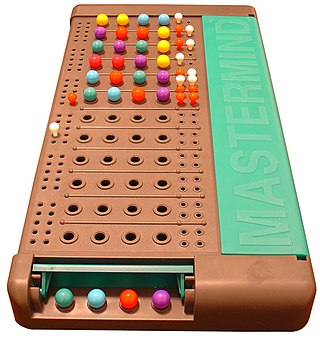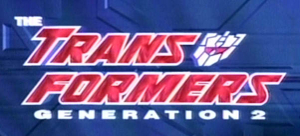
Mastermind or Master Mind is a code-breaking game for two players invented in Israel. It resembles an earlier pencil and paper game called Bulls and Cows that may date back a century.

Simon is an electronic game of short-term memory skill invented by Ralph H. Baer and Howard J. Morrison, working for toy design firm Marvin Glass and Associates, with software programming by Lenny Cope. The device creates a series of tones and lights and requires a user to repeat the sequence. If the user succeeds, the series becomes progressively longer and more complex. Once the user fails or the time limit runs out, the game is over. The original version was manufactured and distributed by Milton Bradley and later by Hasbro after it took over Milton Bradley. Much of the assembly language code was written by Charles Kapps, who taught computer science at Temple University and also wrote one of the first books on the theory of computer programming. Simon was launched in 1978 at Studio 54 in New York City and was an immediate success, becoming a pop culture symbol of the 1970s and 1980s.

The Easy-Bake Oven is a working toy oven introduced in 1963 by Kenner and currently manufactured by Hasbro. The original toy used a pair of ordinary incandescent light bulbs as a heat source; current versions use a true heating element. Kenner sold 500,000 Easy-Bake Ovens in the first year of production. By 1997, more than 16 million Easy-Bake Ovens had been sold.

The National Toy Hall of Fame is a U.S. Hall of Fame that recognizes the contributions of toys and games that have sustained their popularity for many years. Criteria for induction include: icon status ; longevity ; discovery ; and innovation. Established in 1998 under the direction of Ed Sobey, it was originally housed at A. C. Gilbert's Discovery Village in Salem, Oregon, United States, but was moved to the Strong National Museum of Play in Rochester, New York, in 2002 after it outgrew its original home.

The VideoNow is a portable video player produced by Hasbro and released by their subsidiary Tiger Electronics in 2003, and was considered the most popular product in Tiger's line of Now consumer products. The systems use discs called PVDs, which can store about 30 minutes of video, the length of an average TV show with commercials, so each PVD contains only one episode, with trailers at the end to use the leftover time on most PVDs, including Nickelodeon PVDs. Video data is stored on the left audio channel with audio on the right channel, thus making it impossible to achieve stereo sound on the system, which only plays in black and white. The video plays at 15fps. Most of the shows were from Nickelodeon, such as SpongeBob SquarePants and The Fairly OddParents, and later they released shows from Cartoon Network, such as Ed, Edd n Eddy and Dexter's Laboratory, Disney only mostly released episodes of America’s Funniest Home Videos and one Hannah Montana music video. A small amount of movies were also released on the system, but due to the limited space on a PVD, said movies would have to be released on at least three discs, depending on the length of said film.

Marvin Glass and Associates (MGA) was a toy design and engineering firm based in Chicago. Marvin Glass (1914–1974) and his employees created some of the most successful toys and games of the twentieth century such as Mr. Machine, Rock 'Em Sock 'Em Robots, Lite Brite, Ants in the Pants, Mouse Trap, Operation, Simon, Body Language, and the Evel Knievel Stunt Cycle.

Perfection is a game originally produced by the Pennsylvania company Reed Toys and then by the Milton Bradley company. The object is to put all the pieces into matching holes on the board before the time limit runs out. When time runs out, the board springs up, causing many, if not all, of the pieces to fly out. In the most common version, there are 25 pieces to be placed into a 5×5 grid within 60 seconds.

The Transformers: Generation 2 was a Transformers toy line that ran from 1992–1994, in conjunction with a corresponding comic book series and edited reruns of the original cartoon beginning in 1993. The prior Transformer television series, comic books and toys became known as 'Generation 1' or G1 retroactively, and are now officially referred to as such by toymaker Hasbro. Generation 2 was discontinued as the first Beast Wars: Transformers toys began hitting the shelves.

I Love Toys is a miniseries on VH1 and the eighth installment of the I Love the... series that premiered on March 6, 2006. It is a countdown of the 100 greatest toys, chosen partially through public voting on vh1.com and also consideration of "sales, historical significance and longevity," according to VH1.

Milton Bradley was an American business magnate, game pioneer and publisher, credited by many with launching the board game industry, with his eponymous enterprise, which was purchased by Hasbro in 1984, and folded in 1998.

Dot-S also known as Dot-Pin is a toy, similar to a Lite-Brite, created in 2005 by Japanese company Tomytec. The toys allow for the creation of pictures by placing colored pegs into holes in one or more boards. Many sets allow for the creation of various sprite characters from classic video games, with each peg representing one pixel.

The Game of Life, also known simply as Life, is a board game originally created in 1860 by Milton Bradley as The Checkered Game for Life, the first ever board game for his own company, the Milton Bradley Company. The Game of Life was US's first popular parlour game. The game simulates a person's travels through their life, from early adulthood to retirement, with college if necessary, jobs, marriage, and possible children along the way. Up to six players, depending on the version, can participate in a single game. Variations of the game accommodate up to ten players.

Channel letters are custom-made metal or plastic letters commonly used in exterior signage on public and commercial buildings, and often internally illuminated. Unlit three dimensional letters that are applied to sign panels or monuments are usually referred to as dimensional letters.

A Nerf Blaster is a toy gun made by Hasbro that fires foam darts, arrows, discs, or foam balls. “Nerf blaster” or more commonly “Nerf gun” are often used to describe the toy. Nerf blasters are manufactured in multiple forms; the first Nerf blasters emerged in the late 1980s with the release of the Nerf Blast-a-Ball (1989) and the Sharpshooter (1992). Today, Hasbro has produced over twenty unique lines of Nerf-brand blasters, with each line centered on a particular theme or type of ammunition. Hasbro has also produced Nerf blasters based on specific franchises, including Marvel Comics, Star Wars, G.I. Joe, Fortnite, Transformers, Overwatch, Halo Infinite, and Roblox. Nerf blasters are available in several international marketplaces, although some blasters have their names changed or are not sold in certain countries due to laws surrounding toy safety franchises.
Star Wars: The Black Series (TBS) is a Star Wars toy line produced by Hasbro. It includes action figures, vehicles, Force FX lightsabers, and collectable items.

Fuse beads, thermobeads, iron beads, or iron-fusible beads are multicoloured tubular plastic beads that can be arranged into 2D designs on a pegboard, and then fused together by the application of a hot clothes iron through parchment paper to form mosaics. Originally invented as a therapeutic device for the elderly, they were later sold as a children's toy, and have since attracted the interest of hobbyists. Common fuse-bead brands include Hamabeads, Perler Beads, and Nabbi Beads. A similar toy, aqua-dots, are spherical beads that are fused by spraying with water, rather than by the application of heat.













